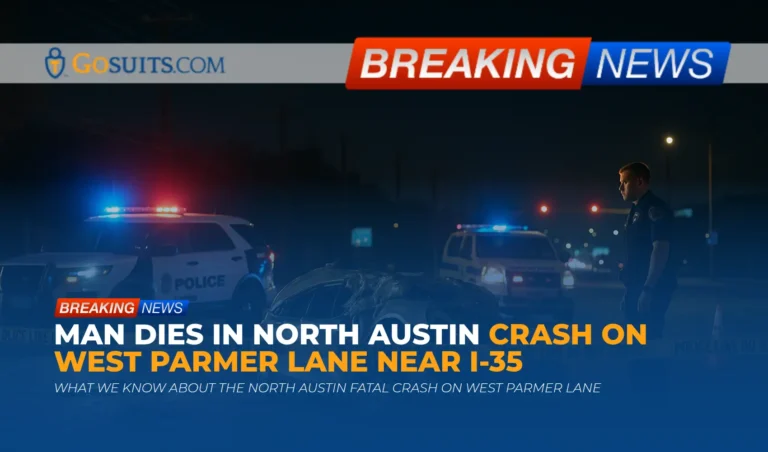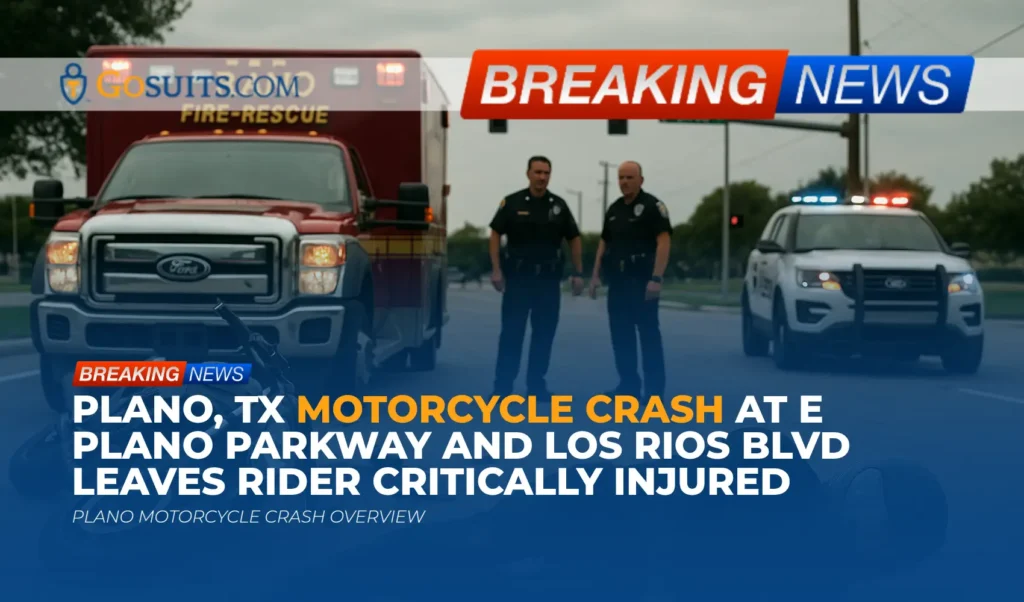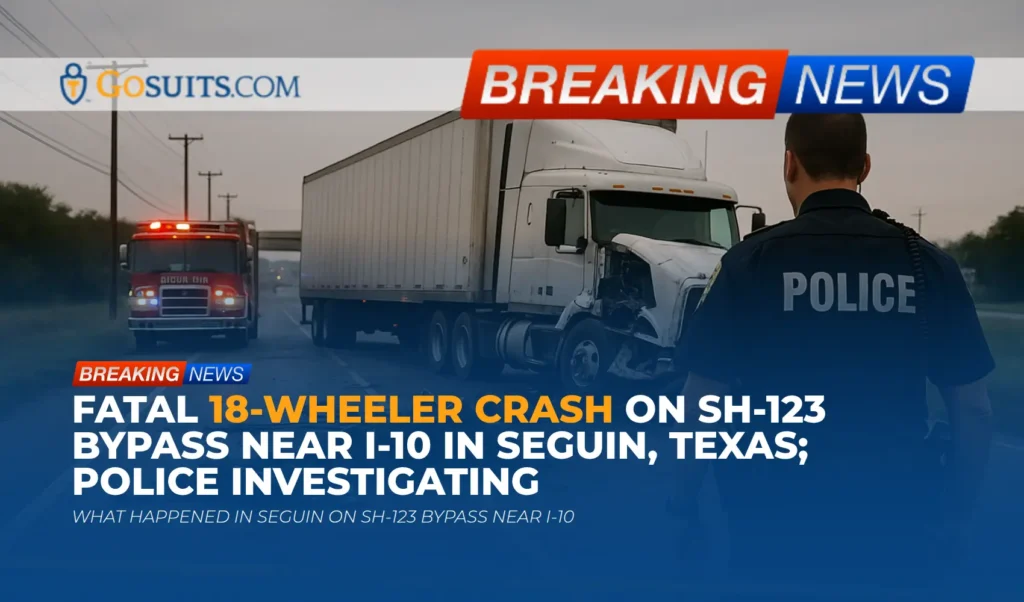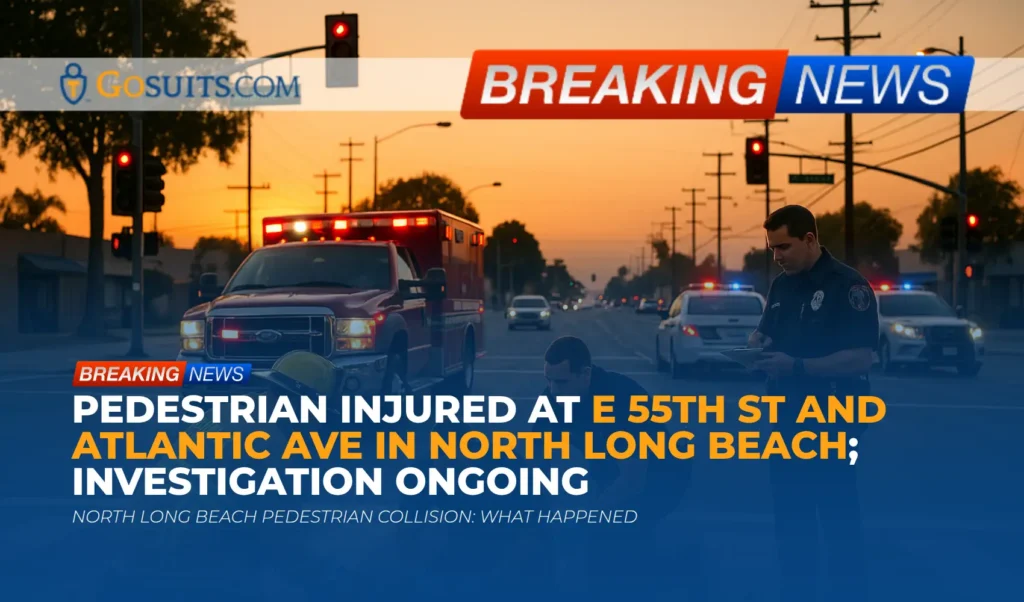- What We Know About the North Austin Fatal Crash on West Parmer Lane
- How Fatal Crash Investigations Typically Proceed in Austin
- Where Families Can Obtain Official Records and Information
- Texas Civil Rights After a Fatal Collision
- Possible Civil Liability Pathways Based on Early Details
- Practical Steps to Protect a Potential Claim
- Supportive Public Resources
- Commentary from Gosuits Austin, Texas Personal Injury Attorney
- Why Acting Quickly Matters After a Serious Crash
What We Know About the North Austin Fatal Crash on West Parmer Lane
According to information released by local public safety agencies, a serious motor vehicle collision occurred late Tuesday evening in North Austin on the 500 block of West Parmer Lane. Austin-Travis County EMS reported the incident around 9:20 p.m. A man was pronounced deceased at the scene. The Austin Police Department’s Watch Command initially noted that the person who died was a pedestrian, but later indicated the individual may have been ejected from a vehicle. Parmer Lane between I-35 and Center Lake Drive was closed in both directions during the response and investigation, with the roadway reopening at approximately 1:30 a.m. the following morning. Police have stated the crash remains under investigation.
These early updates often change as investigators obtain video, physical evidence, and witness statements. It is not uncommon for initial classifications to be refined as more information becomes available, especially when collisions occur at night or involve complex vehicle dynamics such as ejection.
How Fatal Crash Investigations Typically Proceed in Austin
Scene response and evidence collection
After a fatal collision in Austin, police and EMS secure the scene, provide medical assessment, and preserve evidence. Investigators document the roadway, positions of vehicles and debris, damage profiles, skid or yaw marks, fluid trails, and any vehicle intrusion or ejection points. They may canvass for video from nearby businesses, residences, and traffic cameras. Drones or total station mapping tools are sometimes used to measure the scene.
When a death occurs, the local medical examiner’s office takes jurisdiction to determine cause and manner of death. For collisions in Austin, that is the Travis County Medical Examiner’s Office. The medical examiner may perform an autopsy, obtain toxicology samples, and collect medical history as appropriate. This work is separate from the police investigation, but the findings can inform each other.
Clarifying whether the person was a pedestrian or occupant
Early confusion about whether a decedent was a pedestrian can arise when a person is found outside a vehicle. Investigators look for seat belt witness marks, airbag deployment patterns, glass transfer, clothing fibers, and damage to the interior and exterior surfaces to determine if the person was ejected. Vehicle event data recorders, sometimes called black boxes, can indicate whether restraints were buckled, pre-crash speeds, brake usage, and other parameters. These details can take days or weeks to assess.
Reconstruction and contributing factors
Crash reconstruction considers lighting, weather, roadway design, sight lines, traffic control devices, tire condition, mechanical failures, and human factors such as distraction or impairment. If multiple vehicles were involved, investigators analyze contact damage, paint transfer, and crush profiles to understand the sequence of impacts. If the collision was a single-vehicle event, investigators examine road hazards, mechanical issues, and avoidance maneuvers. The outcome of that analysis informs whether any civil liability may exist.
Where Families Can Obtain Official Records and Information
When a fatal collision occurs in Austin, several public agencies maintain records that can help families understand what happened. Availability can depend on whether an investigation is ongoing, so some records may be delayed or partially redacted under Texas public information laws.
Austin Police Department crash reports and records
- Crash report: In Texas, the official crash report is typically obtained through the Texas Department of Transportation’s Crash Records Information System. You can search and purchase the report at cris.txdot.gov/public/Purchase.
- Supplemental records: For other police records, body-worn camera footage, 911 call audio, or photographs, submit a public information request through the City of Austin Open Records Center at austintexas.gov/department/open-records-center. Some materials may be withheld while an active investigation is pending.
- Property and evidence: If personal effects were collected at the scene, the Austin Police Department’s Property and Evidence Unit provides release procedures at austintexas.gov/department/property-and-evidence.
Austin-Travis County EMS patient and incident records
Austin-Travis County EMS maintains patient care reports and dispatch information. Medical records are protected health information and are generally released only to authorized requestors, such as next of kin or estate representatives, under HIPAA. Information about EMS services is available at austintexas.gov/department/ems. EMS can advise on the proper process and forms for requesting patient records.
Travis County Medical Examiner autopsy and reports
The Travis County Medical Examiner’s Office oversees medicolegal death investigations for fatalities in the Austin area. Next of kin can inquire about autopsy and investigative reports and how to request copies for personal records or insurance claims. See official guidance at traviscountytx.gov/medical-examiner. Timelines for report completion can vary due to laboratory testing.
Death certificates and vital records
Final death certificates are issued by the State of Texas. Certified copies can be requested through the Texas Department of State Health Services Vital Statistics. Instructions and eligibility requirements are provided at dshs.texas.gov/vital-statistics/death-records. Funeral homes can often coordinate certificates, but families may also order directly from the state once registration is complete.
Roadway safety context and Vision Zero data
The City of Austin maintains a Vision Zero program that tracks serious injuries and deaths on local roadways and implements safety countermeasures. For general context about corridors, traffic patterns, and safety initiatives, see austintexas.gov/department/vision-zero-program. This information can help families understand how the city evaluates safety risks, though it is not a substitute for a case-specific investigation.
Texas Civil Rights After a Fatal Collision
Texas law recognizes both wrongful death and survival claims in the aftermath of a fatal crash. These are separate civil causes of action, and they serve different purposes. The statutes are available through the Texas Legislature’s official website at statutes.capitol.texas.gov/Docs/CP/htm/CP.71.htm.
Wrongful death claims
A wrongful death claim is brought by the statutory beneficiaries, which typically include the surviving spouse, children, and parents of the person who died. The claim seeks damages allowed by statute for the losses these family members suffer as a result of the death. Eligibility, recoverable losses, and who may file are governed by Chapter 71 of the Texas Civil Practice and Remedies Code.
Survival claims
A survival claim belongs to the decedent’s estate for the personal injury damages the person could have pursued had they lived. It is typically brought by the personal representative or administrator of the estate. The survival statute is also found in Chapter 71 of the Civil Practice and Remedies Code.
Time limits to file
Texas has deadlines, known as statutes of limitations, for bringing civil actions. Many wrongful death and personal injury claims must be filed within two years, subject to specific exceptions. The general limitations statute is available at statutes.capitol.texas.gov/Docs/CP/htm/CP.16.htm. Because deadlines can be affected by facts such as the involvement of a governmental unit or the age of survivors, timely review of the circumstances is important.
Insurance coverage and claims
Multiple insurance coverages may be implicated in a fatal crash, depending on the facts:
- Liability coverage: If another driver or entity is legally responsible, their liability insurance may be called upon.
- Uninsured or Underinsured Motorist (UM/UIM): UM/UIM may apply if a responsible driver has no coverage or inadequate limits. The Texas Department of Insurance provides consumer information on auto coverage options at tdi.texas.gov/pubs/consumer/cb020.html.
- Personal Injury Protection or Medical Payments: These optional coverages can help with certain expenses, subject to policy terms.
Before speaking with any insurance carrier, it is prudent to consult an attorney to understand rights and obligations. Statements to insurers are recorded and can be used later in the claim process.

Possible Civil Liability Pathways Based on Early Details
It is too early to determine fault from the limited public information. However, the scenarios suggested by initial reports can guide the types of questions a civil investigation would explore.
Single-vehicle event with ejection
If the decedent was ejected from their vehicle, investigators would consider whether the seat belt system functioned as intended, whether the vehicle experienced a rollover, and whether road conditions or unexpected hazards led to loss of control. They would also examine whether another vehicle’s actions precipitated the event but left the area. Even in apparent single-vehicle collisions, third-party negligence can sometimes be involved, such as a sudden cut-off or debris spill. Because these issues are fact intensive, preservation of vehicle data and scene evidence is important.
Multi-vehicle collision or impact with pedestrian
If evidence supports involvement by another motorist, liability analysis may consider speed management, distraction, impairment, compliance with traffic control devices, and yielding. In pedestrian-involved crashes, questions include lighting, crosswalk availability, pedestrian right-of-way, and driver attentiveness. The presence of a pedestrian or an ejected occupant outside a vehicle can look similar in the moments after a crash. Careful reconstruction helps clarify which occurred.
Ejection and the importance of restraints
National safety data consistently show that ejection greatly increases the risk of fatal injury in a crash, and that proper seat belt use reduces the risk of fatal and serious injury. For general safety information, see the National Highway Traffic Safety Administration’s overview on seat belts at nhtsa.gov/risky-driving/seat-belts. Whether restraints were used or functioned properly is a technical question that often requires inspection of the vehicle and its components. Families should avoid drawing conclusions until the vehicle and its data are preserved and reviewed.
Roadway design and corridor risk
West Parmer Lane is a major arterial with high traffic volumes. Roadway design, lighting, speed limits, and crossing opportunities can influence crash risk and severity. The City of Austin’s Vision Zero program applies data-driven approaches to reduce severe crashes on such corridors. An overview of the city’s safety program is available at austintexas.gov/department/vision-zero-program. In civil cases, if roadway design or maintenance is implicated, different notice requirements and immunities may apply, which can affect timelines and procedures.
Practical Steps to Protect a Potential Claim
In the days and weeks following a fatal collision, certain steps can help preserve clarity and options. These are general considerations and timelines can vary.
Preserve evidence early
- Vehicle preservation: Locate the involved vehicle and ensure it is not destroyed or repaired until it can be inspected. The event data recorder may contain pre-crash information that can be lost if the battery is disconnected or the car is salvaged.
- Scene and video: Identify nearby businesses, residences, or transit stops that may have exterior cameras covering West Parmer Lane near I-35 and Center Lake Drive. Many systems overwrite footage quickly. A prompt request can prevent loss.
- Witnesses: Write down names, phone numbers, and what each person saw. Even small details, such as the sound of braking or direction of travel, can matter later.
- Digital records: Secure dashcam footage, phone photos, and vehicle telematics accounts if applicable.
- Medical and funeral records: Keep copies of all expenses and communications related to the death, as insurers often require documentation.
Request official records
- Crash report: Monitor availability of the Texas Peace Officer’s Crash Report via TxDOT at cris.txdot.gov/public/Purchase. It can take days or weeks to appear.
- Autopsy and toxicology: Contact the Travis County Medical Examiner at traviscountytx.gov/medical-examiner for report timelines and process.
- Open records: Use the City of Austin Open Records Center at austintexas.gov/department/open-records-center to request supporting materials. Be aware that active investigations may limit immediate release.
Communicating with insurers
- Consult an attorney first: Before any recorded statement or form submission to an insurance carrier, consult with an attorney. What is said to an insurer can be used against the claimant later.
- Policy review: Determine whether the decedent had UM/UIM, PIP, MedPay, or other coverages. The Texas Department of Insurance’s consumer guide to auto insurance is at tdi.texas.gov/pubs/consumer/cb020.html.
- Do not speculate: Share only verified facts and documents. Avoid opinions about speed, distraction, or fault until the investigation is clear.
Social media and public statements
It is wise to avoid posting about the crash or sharing theories publicly. Public posts and comments can be saved out of context and may affect future proceedings. If approached by media, a short statement that the family is awaiting official findings is often sufficient.
Supportive Public Resources
Crime Victims’ Compensation Program
If the crash involved criminal conduct, eligible claimants may seek certain financial assistance through the Texas Crime Victims’ Compensation Program. Eligibility and covered benefits are defined by state law and administered by the Office of the Attorney General. Details are available at texasattorneygeneral.gov/crime-victims/crime-victims-compensation-program. This program has specific requirements and is separate from any civil claim.

Grief and trauma support
Sudden loss can be overwhelming. The Substance Abuse and Mental Health Services Administration provides a national helpline and resources for mental health support. See samhsa.gov/find-help/national-helpline for information about counseling and support services. Local county resources may also be available through health and human services departments.
Death certificates and vital records assistance
State guidance for obtaining certified death certificates is available through the Texas Department of State Health Services at dshs.texas.gov/vital-statistics/death-records. These documents are often required by insurers, employers, and financial institutions.
Commentary from Gosuits Austin, Texas Personal Injury Attorney
We are deeply sorry to learn of the death reported on West Parmer Lane in North Austin. Lives change in an instant with roadway tragedies, and families are left searching for answers. This article is intended for general information to help the community understand the process that follows and the avenues available to obtain records and clarity.
Based on the early details, investigators are working to determine whether the decedent was a pedestrian or an occupant who was ejected. That distinction matters, but the core priority remains the same. Preserve evidence, gather official reports, and allow qualified professionals to reconstruct what happened. Ejection scenarios can involve complex questions about vehicle dynamics, restraint systems, and roadway conditions. Pedestrian scenarios involve lighting, crosswalks, yielding, and driver attentiveness. Each path requires a careful, methodical review rather than assumptions.
Insurance companies and large corporate stakeholders are trained to move quickly after serious crashes. Their adjusters may request recorded statements, broad medical authorizations, or early signed releases before families have all the facts. These tactics can capitalize on stress and uncertainty. Once certain statements are made or documents are signed, it can be difficult to correct the record. Taking time to understand rights, coverages, and the scope of losses helps prevent missteps that can affect recovery under the law.
Speaking with a seasoned attorney for a free consultation before engaging with insurers can help clarify options and obligations. It also provides a buffer from claims handling pressure while official reports and autopsy findings are pending. No two cases are the same, and a tailored discussion can surface issues that are not obvious at the outset, including potential UM/UIM claims or notice requirements if a governmental entity or roadway condition may be involved.
Why Acting Quickly Matters After a Serious Crash
There are concrete, time-sensitive steps that can make a meaningful difference in how a serious collision is documented and understood. Acting sooner rather than later can preserve crucial information.
- Secure the vehicle and its data: Vehicles are often towed to storage lots where daily fees accrue. Before a vehicle is released, salvaged, or repaired, arrange for it to be preserved. Event data recorders can hold key pre-crash information that may not be recoverable later.
- Request official records as they become available: Place calendar reminders to check for the Texas Peace Officer’s Crash Report through TxDOT. Submit records requests to the City of Austin and the Travis County Medical Examiner to begin the queue, knowing that releases may occur in stages.
- Identify and contact potential witnesses: Memories fade quickly. A respectful, prompt follow-up to confirm contact details and a brief account can help when formal statements are needed.
- Document out-of-pocket costs and impacts: Keep receipts and correspondence for funeral expenses, travel, and related costs. Organized documentation reduces delays with insurers and other programs that may require proof of loss.
- Avoid premature insurer interactions: Before giving recorded statements or signing releases, consult with an attorney. Early communications can shape claim outcomes, and what is said can be used by carriers later.
- Monitor legal timelines: Texas civil claims are subject to filing deadlines, and some claims require earlier notice, especially if a governmental entity may be involved. Timely action helps maintain all available options.
Taking these steps early provides a clearer picture of what happened and helps ensure that important rights are not lost to the passage of time or the routine destruction of evidence.






